After serving as royal residence for numerous years, the Louvre was finally converted into a museum to display the nation’s masterpieces by the National Assembly during the French Revolution. The museum opened on August 10, 1793 with an exhibition of 537 paintings. Today, with a collection that spans work from ancient civilizations to the mid-19th century, the Louvre is the largest art museum in the world. Located in Paris, France, it is also the world’s most visited art museum, receiving 10.2 million visitors in 2018. The collection of artworks at Louvre includes paintings and sculpture from various art movements. These include the Renaissance, a movement which was marked by renewed interest in ancient Greco-Roman art; Neoclassicism, which drew inspiration from classical art; and Romanticism, which laid emphasis on emotion and individualism as well as glorification of the past and of nature. Here are the 10 most famous artworks at the Louvre including ancient sculptures like Venus de Milo and Winged Victory of Samothrace; Renaissance masterpieces like the Mona Lisa; Neoclassical paintings like the Oath of the Horatii; and iconic Romanticism works like Liberty Leading the People.
#10 The Intervention of the Sabine Women
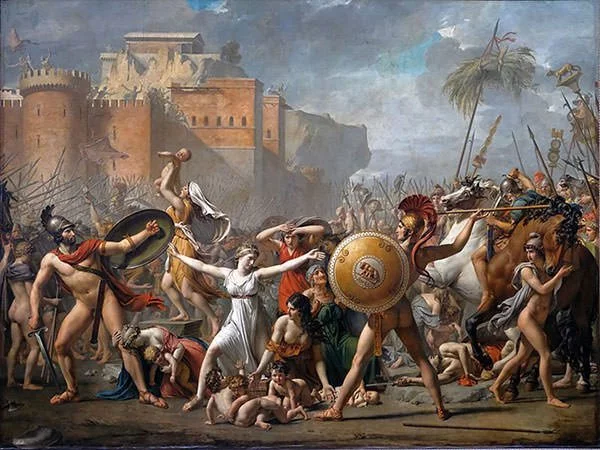
| French Title: | Les Sabines |
| Artist: | Jacques-Louis David |
| Year: | 1799 |
Jacques-Louis David was a Neoclassical French painter who is widely regarded as the leading French artist of his era. This painting is based on Roman mythology. According to legend, shortly after the founding of Rome, the Romans sought wives to begin their families but they were unsuccessful in negotiating with the Sabines, who populated the surrounding area. They then committed a mass abduction of young women, an episode known as the Rape/Abduction of the Sabine Women. Depictions of the incident became common in art after the 15th century. In this painting, David represents the aftermath of the incident when the women intervene to reconcile the warring parties. In it, Hersilia, wife of Romulus and daughter of Titus Tatius, the leader of the Sabines, intervenes between her father and her husband placing her children between the warring leaders. The Intervention of the Sabine Women was also relevant for the time it was created as it put forward the idea of love prevailing over conflict after the bloodshed of the French Revolution.
#9 Dying Slave
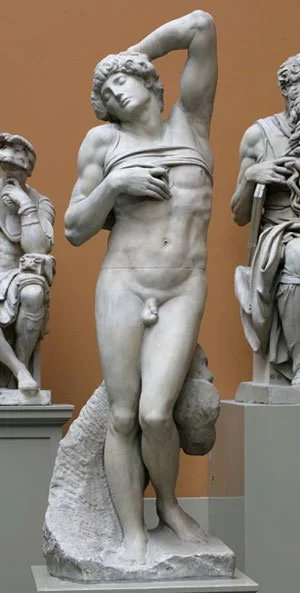
| French Title: | L’Esclave mourant |
| Artist: | Michelangelo |
| Year: | 1516 |
The Dying Slave, along with another statue of Michelangelo titled Rebellious Slave, was commissioned to him in May 1513 as part of a plan for the for the tomb of Pope Julius II. However, the statues were not part of the final plan and thus never served their intended purpose. When Michelangelo was sick in the period between 1544 and 1546, he had stayed at the house of Roberto Strozzi, a fellow Florentine resident in Rome. In gratitude of the generous hospitality of Strozzi, Michelangelo presented these two sculptures to Strozzi. When he was exiled from Italy, Strozzi took the two sculptures with him to France. They eventually became part of the French national collection in 1793. Several art experts including Richard Fly believe that the Dying Slave depicts the moment of death when the body loses all its vitality to become a lifeless form. However, some others reject this interpretation giving other meanings to the statue.
#8 Grande Odalisque
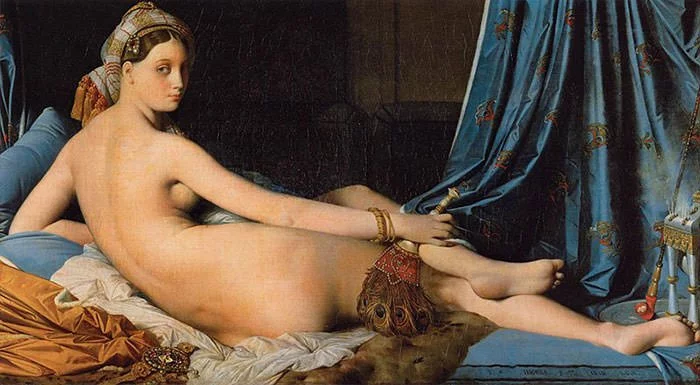
| French Title: | La Grande Odalisque |
| Artist: | Jean-Auguste-Dominique Ingres |
| Year: | 1814 |
Ingres was a 19th century French painter most renowned for his portraits. The word “odalisque” is French in form and originates from the Turkish odalık, meaning “chambermaid”. It is generally used to denote a slave and/or a prostitute. The Grande Odalisque was commissioned by Napoleon’s sister, Queen Caroline Murat of Naples. The painting draws inspiration from earlier reclining nudes like Titian’s Venus of Urbino. However, unlike them, it has unreal elongated proportions and is not anatomically accurate. Studies have shown that the figure has an impossible curvature of the spine and rotation of the pelvis. Moreover, her left hand is shorter than the right. Initial criticized for its anatomical abnormalities, the Grande Odalisque is now renowned for the same reason with people believing that the abnormalities are symbolic in nature. For example it is believed that the pelvic area of the concubine has been purposefully elongated to show that she is primarily used to satisfy the carnal pleasures of the sultan.
#7 The Death of Sardanapalus
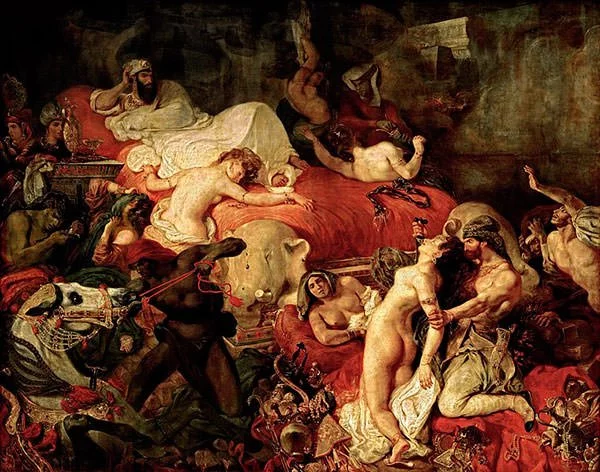
| French Title: | La Mort de Sardanapale |
| Artist: | Eugène Delacroix |
| Year: | 1827 |
Eugene Delacroix was the leading artist of the French Romantic era of the 19th century and he is regarded as the greatest French painter of his time. Sardanapalus was the last king of Assyria according to the Greek writer Ctesias. It must be mentioned that this is not true and in fact, there is little resemblance of Sardanapalus to any known Assyrian king. Anyway, Sardanapalus is portrayed as a self-indulgent king who dies in an orgy of destruction. This portrayal of his death served as a theme in Romantic literature and art. One of the best known works on the subject as well as that of the artist, The Death of Sardanapalus depicts the king overseeing, with a disinterested eye, the destruction of all his possessions in a funerary pyre of gore and excess. Among other things, it portrays a number of women in various degree of undress struggling against death by the hands of the men in the picture. Apart from its rich colors and its broad brushstrokes, the painting is famous for being an early Romantic work which challenged neoclassical traditions.
#6 Winged Victory of Samothrace
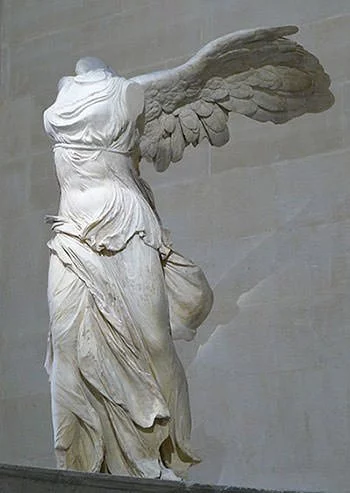
| French Title: | Victoire de Samothrace |
| Artist: | Unknown |
| Year: | 2nd Century BCE |
A marble Hellenistic statue, the Winged Victory of Samothrace is one of the primary attractions at Louvre and one of the most famous sculptures in the world. It is dedicated to the Greek goddess of victory, Nike. Samothrace is a Greek island in the northern Aegean Sea and the statue was part of the Samothrace temple complex, also known as the Sanctuary of the Great Gods. It represents the goddess of victory descending from the skies to the triumphant fleet. The head as well as the arms of the sculpture have been lost. It is believed that the right arm of Nike was raised, cupped round her mouth to deliver the shout of Victory. It has also been suggested that Pythokritos of Lindos was the sculptor who created the artwork. Which event is being celebrated through the statue remains a matter of conjecture with several proposals ranging from the Battle of Salamis in 306 BC to the Battle of Actium in 31 BC. The Winged Victory of Samothrace has been called “the greatest masterpiece of Hellenistic sculpture” by prominent art historian H. W. Janson.
#5 Oath of the Horatii
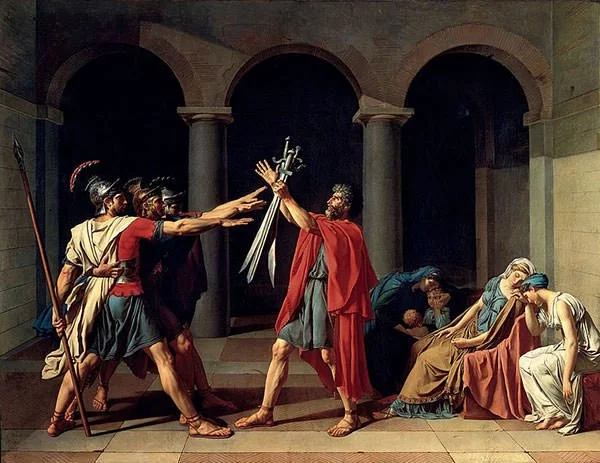
| French Title: | Le Serment des Horaces |
| Artist: | Jacques-Louis David |
| Year: | 1784 |
This large painting represents a scene from a Roman legend. According to it, two warring cities of Rome and Alba Longa agree to send three fighters each to resolve the dispute. The side which wins the contest would win the war. From Rome, the three men are brothers from the family known as the Horatii. In the painting, the three brothers salute their father who is holding the swords for them. Only one brother will go on to survive the contest and kill the three brothers from the Curiatii family of Alba Longa. In the right corner of the painting, David represents Camilla. She is the sister of the Horatii brothers. Moreover, she is engaged to one of the Curiatii brothers. Camilla is weeping in the painting as no matter who wins she will lose a loved one. The artwork focuses on the theme of patriotism and sacrifice for one’s country. The Oath of the Horatii was highly acclaimed immediately and since then it remains one of the most famous paintings in the Neoclassical style.
#4 The Raft of the Medusa
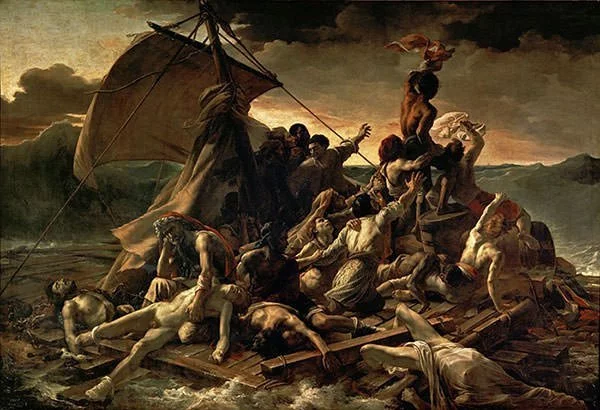
| French Title: | Le Radeau de La Méduse |
| Artist: | Théodore Géricault |
| Year: | 1819 |
Méduse was a French warship which fought in the Napoleonic Wars. Though it survived the battles, it crashed in a sandbank in July 1816 while transporting people to Senegal. The 400 people on board had to evacuate; out of which 151 were put on a raft. These men on the raft had to go through a terrible ordeal. Many were washed into the sea by a storm; others rebelled and were killed by officers; the survivors engaged in cannibalism; and when supplies ran low, injured men were thrown into the sea. After 13 days on sea, the raft was found with only 15 men surviving. The event became an international scandal. Théodore Géricault thoroughly studied the incident before creating this masterpiece. The Raft of the Medusa proved to be hugely influential in French art; is considered an iconic work of French Romanticism; and has immortalized the incident it depicts.
#3 Liberty Leading the People
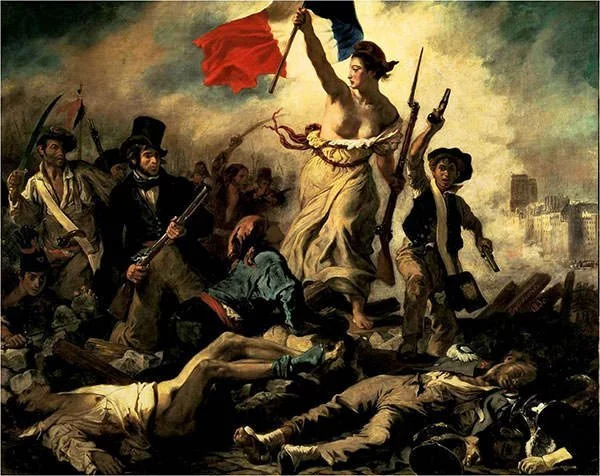
| French Title: | La Liberté guidant le peuple |
| Artist: | Eugène Delacroix |
| Year: | 1830 |
Liberty has existed as a goddess in many cultures and during the French Revolution, many allegorical personifications of ‘Liberty’ appeared in France. Since then the figure of Liberty is viewed as a symbol of France and the French Republic. This painting commemorates the July Revolution of 1830 in which King Charles X of France was overthrown. It shows Liberty as both a goddess and a robust woman of the people. She holds the flag of France in one hand and a firearm in her other hand. Liberty Leading the People is a hugely influential artistic work. Among other things, it has been a source of inspiration for the Statue of Liberty and Victor Hugo’s renowned novel Les Misérables. Since its creation, the painting has also served as a republican and anti-monarchist symbol. The masterpiece of the leading French Romantic painter, Liberty Leading the People tops the list of the most famous paintings of the Romanticism movement. Moreover, it is the most famous painting by a French artist at the Louvre.
#2 Venus de Milo
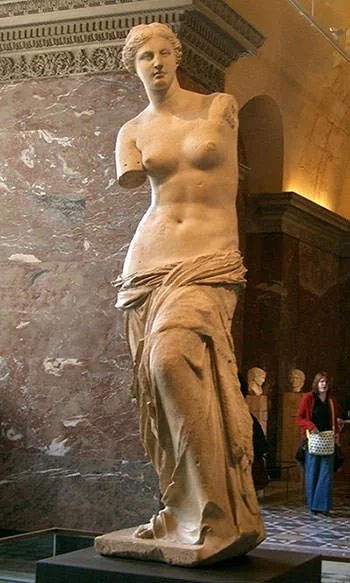
| Artist: | probably Alexandros of Antioch |
| Year: | between 130 BCE and 100 BCE |
It is generally believed that this statue was discovered on 8th April 1820 by a peasant named Yorgos Kentrotas. He found it in pieces on Milos, a Greek island in the Aegean Sea. The sculpture was subsequently presented to King Louis XVIII of France who then gave it to the Louvre, where it is on display to this very day. Also known as Aphrodite of Milos, Venus de Milo is thought to represent Aphrodite, the ancient Greek goddess of love, beauty, pleasure and procreation. The Roman goddess counterpart to Aphrodite was Venus. The statue is believed to have been carved by Alexandros of Antioch, a sculptor of the Hellenistic period. Apart from the much discussed mystery about its missing arms, it was originally draped in jewelry including a bracelet, earrings and a headband. However all these things have been long lost. Venus de Milo is perhaps the most famous work of ancient Greek sculpture. It has been widely referenced in popular culture and has greatly influenced modern artists including Salvador Dali. It is the most famous sculpture at the Louvre.
#1 Mona Lisa
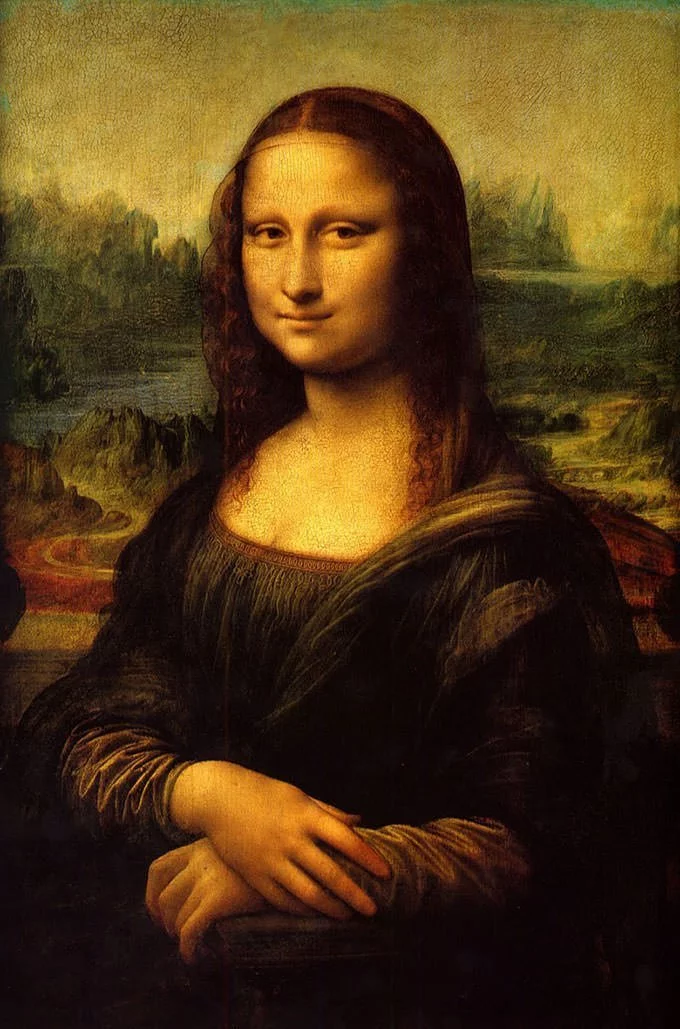
| Artist: | Leonardo da Vinci |
| Year: | 1517 |
Leonardo da Vinci is regarded as the preeminent figure of the Italian Renaissance. His masterpiece, the Mona Lisa has been acclaimed as “the best known, the most visited, the most written about, the most sung about and the most parodied work of art in the world”. Its fame rests, in particular, on the elusive smile on the woman’s face which is why it is also known as “la Gioconda”, or the laughing one. Based on accounts from an early biographer, the painting is a picture of Lisa Gherardini, the real-life wife of a merchant. For Da Vinci, Mona Lisa was forever a work in progress, as it was his attempt at perfection. The painting was never delivered to its commissioner; he kept it with him till the end of his life. Guinness World Records lists the Mona Lisa as having the highest insurance value for a painting in history. It was assessed at US$100 million on December 14, 1962, which after adjusting inflation, would be around US$790 million in 2016. Being the best known painting in the world, Mona Lisa is the most famous artwork at the Louvre.

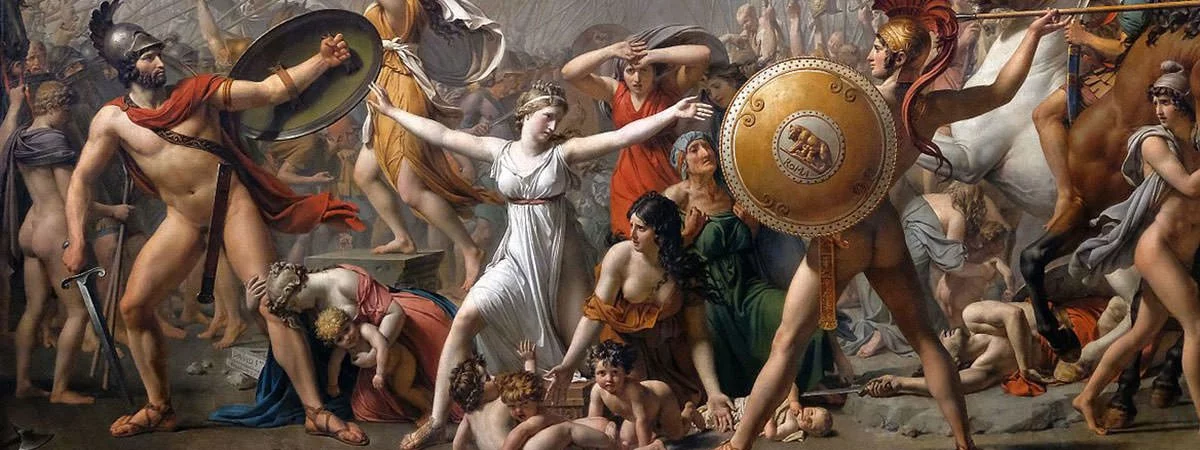
I found this information incredibly interesting and informative and will be sharing it with my friends and family. Thank you for such a easy to understand and enjoyable piece of work
Thanks for your appreciation.